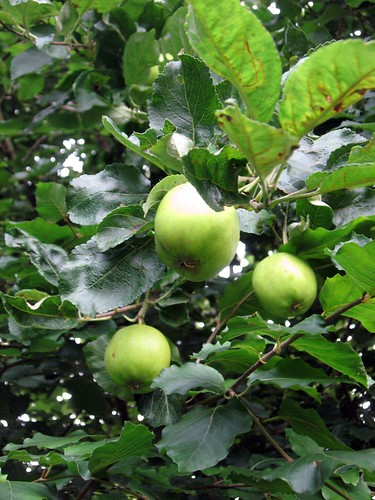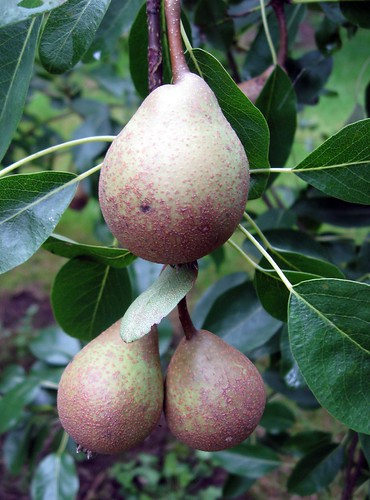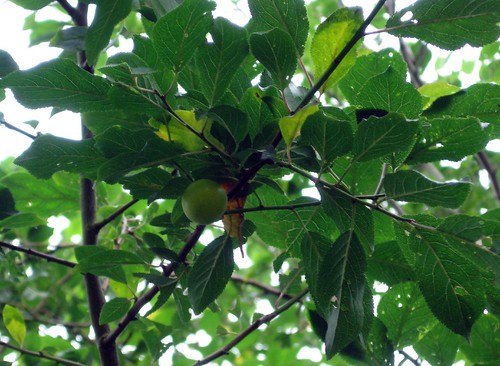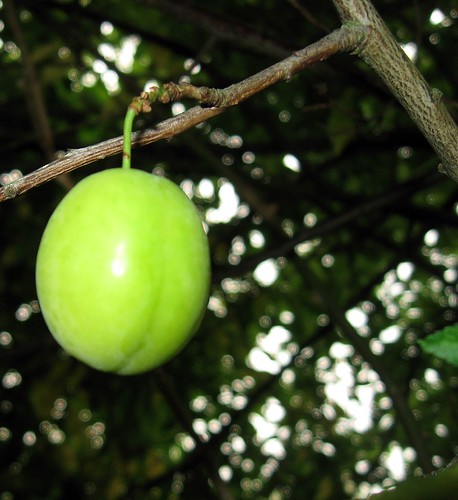As we've seen hedges can provide wonderful habitats for birds and small mammals offering food and shelter. One of the more obvious ways in which they can help is where the plants chosen produce a lot of food in the form of fruit, nuts and berries. We'll look at berry producing hedgerow shrubs in another post but in this post I'll be dealing with some fruiting hedgerow shrubs and trees that will be familiar to most people. I've posted before about hedgerow apples arising from throwaway cores and also about crabapple cultivars but in this hedge what I had in mind were simple wild crabapples that would produce an abundance of small round fruit for the birds and perhaps supplement our crabapple jelly production a little. What I got when they started fruiting years later was this:
As you can see its unquestionably a cultivated fruit apple of some kind. I think what happened was this. The crabapple plants and a number of others were given to us as spares by a grower who had produced a load of native plants for the local council. It turned out later he had also produced some plants of the county's own heirloom apple cultivars (most counties in the UK have (or had) their own apple cultivars for years many of which are now lost or rare) and I'm guessing these are some of them or seedlings influenced by them. It doesn't really matter; thrushes and blackbirds will still tuck in and if I was doing this again on a bigger scale I'd be tempted to throw in wild crab apples, cutting grown (as opposed to grafted) crabapple cultivars and some random apple core seedlings in to see what sort of a mix of colour and size I ended up with (all I need now is the lottery win which will let me buy a farm to rehedge!). The same chap helpfully provided some "wild pear" which seem to be of a similar semi-wild origin. Like apples these will provide fruit for the birds and small mammals as well as insect attracting flowers.
We obtained some "true wild pears" from elsewhere so I'll await their development and fruit with interest too. The "truly wild" relatives of a couple of other fruits made it into the hedge. These were the wild cherry or gean (Prunus avium):
And the cherry plum (Prunus cerasifera)
Anyone who has tried to get a crop of their domestic relatives will be well aware of how much these fruits are appreciated by the birds. I was surprised by how big the cherry plums were; impressive fruit for what is still a small specimen. If one wants to get a bit clever, one option is to do away with wild forms and hedge entirely with things that produce fruits for human consumption (a "fedge" is the term frequently used for this but that's just ridiculous), you can even choose larger fruiting species of thorn as a base to take this to a higher level. Its worth noting that most of these species fruit better as trees and some will not fruit at all if the hedge is very neatly pruned. If like me, you like your hedges a little shaggy you'll be fine but the other option is to choose certain specimens to prune into trees rising above your neatly pruned hedge.




1 comment:
I like to have one of these fruit trees in my yard just for the birds. But, I do not think the climate I live in would be right for fruit trees. The pears looks so yummy.
Post a Comment